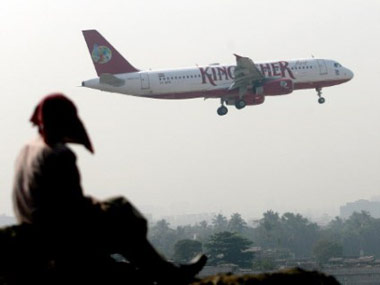Yes, according to a recent report by Kotak Institutional Equities.
The financially troubled airline’s debt is officially pegged at Rs 7,500 crore at the end of September but the brokerage claims that the figure is understated “ascurrent liabilities, a large part of which comprise overdue payments, are very high for the company,” in a report authored by Jasdeep Walia. The report was highlighted on Monday by Business Standard.
The current liabilities of Kingfisher total Rs 5,000 crore, the brokerage pointed out. That is similar to the liabilities of Jet Airways, although Jet’s quarterly sales are a little more than twice those of Kingfisher’s.
“Going by that assumption, one could say that almost half the current liabilities of the airline are overdue payments and hence equivalent to debt (as punitive interest is charged for overdue payments). Therefore, in our view, actual debt in Kingfisher’s balance sheet is closer to Rs 100 billion (Rs 10,000 crore),” the report concluded.
[caption id=“attachment_136007” align=“alignleft” width=“380” caption=“Reuters”]  [/caption]
In addition, unlike airlines which complained about a tough operating environment, the brokerage thought the September-ended quarter was the “best” quarter for the aviation sector to date, pointing out the three months experienced the benefits of high passenger load factors (a measure of how much an airline’s passenger-carrying capacity is used), high air fares, high passenger traffic and subdued fuel prices (Nymex crude was in the range of $85-90 per barrel).
“In our view, if an airline could not make money in 3QFY11 (September-ending quarter), it is almost impossible to make profits without a significant capital infusion (which would reduce interest expense),” the report said.
Impact Shorts
More ShortsWalia also highlighted that Kingfisher was the only airline to not make a profit at the profit before tax level (excluding one-offs) in the three months to September. In order to sustain operations, the airline needed large capital infusions and a reduction in interest rates, the report said.“Small capital infusion or incremental increase in working capital limits can only sustain operations for some more time,” it added.
Overall, the report acknowledged the need for reforms in the sector. Several experts have raised the issue of high jet fuel costs - taxes on jet fuel are a steep 24 percent - for airlines, and have urged the government to cut those taxes.
“In our view, one of the major policy responses could be reduction of state sales tax on fuel from average levels of 24 percent (average across states) to 4 percent. This could be done by changing the status of jet fuel to ‘declared goods’ which would attract uniform state sales tax of 4 percent across India,” Walia wrote.
But the author also acknowledged that this could be a difficult task since reducing the tax would cause an annual loss of Rs 2,500 crore to state governments.“In our view, the tab is much lower than what the government would have to bear in case the situation persists for long as most of the non-performing assets would be borne by public-sector banks,” the report noted.
Moreover, “the government could also look at reducing customs duty (5 percent) and excise duty (10 percent) on jetfuel in case the above-mentioned rationalisation of state sales tax proves difficult asbuilding consensus among different states could prove to be a time-consuming exercise,” it added.
The author also believed that raising the FDI limit for foreign carriers would not really solve the industry’s problems because very few airlines would be interested in making large investments in the sector, given the structural constraints.


)

)
)
)
)
)
)
)
)



